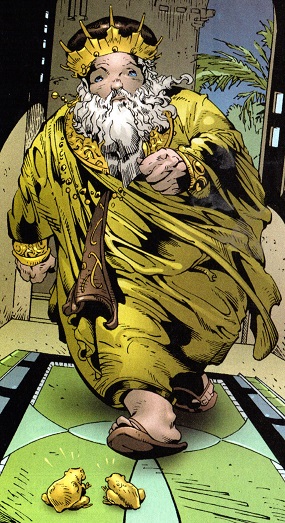 KING SOLOMON
KING SOLOMON KING SOLOMON
KING SOLOMON
Real Name: Solomon (or Shlomoh; see comments)
Identity/Class: Human magic-user;
Citizen (king) of the United Kingdom of Israeli;
post-Hyborian/BC
era
Occupation: Sorcerer, king;
former Sorcerer Supreme
Group Membership: Sorcerers Supreme
Affiliations: Aged Genghis, Balkis (the Queen of Sheba), Phoenician King Hiram I of Tyre, Magar the Mystic, the Vishanti (Hoggoth, Oshtur, Agamotto);
revered as a prophet or more in many religions, including Christianity, Hebrew, Islam, and Rastafarianism;
Mechamage (utilized the Solomon Seal), Solomon Kane (used the Staff off Solomon);
formerly Yahweh (the Judeo-Christian God);
allegedly the Angels of Heaven
Enemies: Allegedly Asmodeus, Lilith (Mother of Demons), Maralith, other demons
Known Relatives: David (father), Bathsheba (mother);
Nathan, Shammua, Shobab (brothers);
Adonijah, five other paternal half-brothers (each from a different mother);
Naamah and allegedly 699 others (wives);
Rehoboam (son by Naamah);
Per the Bible, Solomon is descended from Abraham, Noah, and Adam. (see comments)
many others (see comments)
Aliases: Jedidiah, Shlomoh, Sulayman;
the wisest of wise men
Base of Operations: Unrevealed; his body is apparently interred in "King Solomon's Tomb" in the Atlas Mountains of the Sahara Desert;
formerly Jerusalem, Israel
First Appearance: (As far as I can, Solomon
was first referenced in) the First Book of Kings in the Hebrew Bible
(perhaps written sometime around 600 BC);
(Marvel version referenced) Red Raven#1/8 (August, 1940)
Powers/Abilities: Solomon is most renown for
his wisdom. He had great skill in judging right from wrong, and he was
extremely talented in manipulating others to force them to reveal their
true natures.
Solomon was one of the most powerful magic
users of his era. He could almost certainly access the astral plane
and other dimensions,
transport others across dimensional barriers, project magical bolts,
magically extend his lifespan to well over 300 years, and call on
power
from entities such as the Vishanti.
Solomon allegedly could command angels and demons.
He presumably possessed and could utilize the Book of the Vishanti and the Eye(s) of Agamotto.
The full range of his abilities remains unrevealed.
A skilled leader, Solomon was
legendary for his wisdom. He is also well known for the wealth and
legendary artifacts he accumulated.
The many items accumulated by Solomon include the Brass Frogs, the Key of Solomon, the Goetia (Lesser Key of Solomon), Solomon's Seal, and the Staff of Solomon.
Height: Unrevealed
Weight: Unrevealed
Eyes: Unrevealed (possibly blue)
Hair: White beard, at least (black hair and beard as young man)
History:
(Black Panther I#1 (fb) - BTS) - Solomon lived a fantastic life and accumulated fantastic treasures.
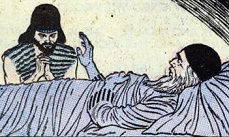 (Bible
Tales for Young Folk#4 (fb)) - Growing old, David chose his Solomon --
who had the spirit of the lord upon him, as opposed to his ambitious
half-brother Adoniajh -- as his successor. After advising Solomon to be
strong and be a man, to walk in the ways of God (Yahweh), and to rule
with wisdom and kindness, David died.
(Bible
Tales for Young Folk#4 (fb)) - Growing old, David chose his Solomon --
who had the spirit of the lord upon him, as opposed to his ambitious
half-brother Adoniajh -- as his successor. After advising Solomon to be
strong and be a man, to walk in the ways of God (Yahweh), and to rule
with wisdom and kindness, David died.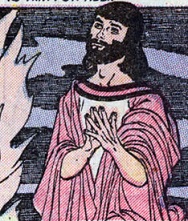
(Bible Tales for Young Folk#4 (fb)) - Making sacrifices to God from a mountaintop, Solomon was visited by God in a dream. Asking for an understanding heart to judge his people and to tell what was right vs. wrong, Solomon impressed God with his selfless request, and God granted him wisdom, as riches and honor to become the greatest king, as long as Solomon walked in God's path.
(Bible Tales for Young Folk#4 (fb)) - Solomon had built a great temple to God in Jerusalem.
(Bible Tales for Young Folk#4 (fb)) - Solomon was visited by the Queen of Sheba, who was impressed with his immense wealth and wisdom, credited both to his being a man of God.
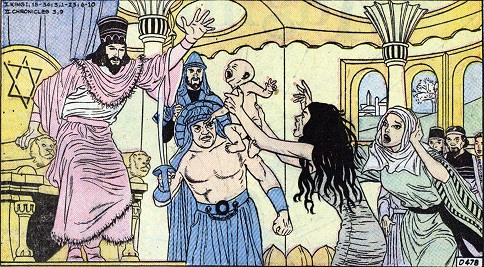 (Bible
Tales for Young Folk#4 (fb)) - Followers of Adonijah and other
opponents of Solomon sought to discredit him by forcing him to judge a
dispute over two women who each claimed a baby as their own (with one
of the women's child having died overnight). When Solomon prepared to
have the baby cut in half and split between the two women, Solomon
recognized the true mother as the one who renounced her claim to the
child in order that it would survive.
(Bible
Tales for Young Folk#4 (fb)) - Followers of Adonijah and other
opponents of Solomon sought to discredit him by forcing him to judge a
dispute over two women who each claimed a baby as their own (with one
of the women's child having died overnight). When Solomon prepared to
have the baby cut in half and split between the two women, Solomon
recognized the true mother as the one who renounced her claim to the
child in order that it would survive.
(Real world history/legend) - King Solomon is conventionally believed to have reigned over the united monarchy of Israel from 970-931 BC.
(Bible Tales for Young Folk#1 (fb) - BTS) - Solomon wrote much of the Hebrew Bible (aka the Old Testament)'s book of Proverbs.
(Black Panther I#1 (fb) - BTS) - The Brass Frogs were given to King Solomon as a royal gift during his reign as a gift.
(Marvel Tarot (fb) - BTS) - At some point, King Solomon summoned and enslaved the serpentine demoness Maralith, a descendent of Set, who had the lower half ofserpent, and the torso and arms or a woman. He gave information about her and the means for her capture in his (alleged) books on Spirit Summoning and Binding, entitled ... THE BOOK OF THE GOETIA or THE LESSER KEY OF SOLOMON and THE GREATER KEY OF SOLOMON THE KING.
(Marvel Preview#19/2 (fb) - BTS) - At some point
Solomon received a powerful staff marked with the cat-head representing
the Heliopolitan/Ennead god/goddess Bast, formerly held by the Priests of Bast and later by Moses. The staff eventually became known as the Staff of Solomon.
(Marvel Tarot#1 / Official Handbook of the Marvel Universe A to Z (hardcover) Vol. 7: Appendix: Magic (from the journals of Ian McNee) (fb) - BTS) - The legendary King Solomon succeeded Salomé' as Earth's Sorcerer Supreme, replacing her madness with wisdom and stability from 1100 to 800 BC. He also added to the library of mystic knowledge. The Key of Solomon the King and The Goetia or the Lesser Key of Solomon are still consulted for advice on summoning and binding spirits.
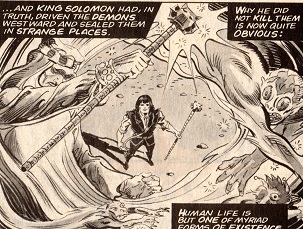 (Marvel Preview#19/2 (fb)) - Solomon used the Staff of Solomon to drive demons westward, sealing them in strange places.
(Marvel Preview#19/2 (fb)) - Solomon used the Staff of Solomon to drive demons westward, sealing them in strange places.
(Official Handbook of the Marvel Universe A to Z
(hardcover) Vol. 6: Lilith) - Ancient stories (circa 1000 BC) claim
that Lilith joined other demons to challenge Israel’s King Solomon, who
enslaved and banished many such demons, including some of the Lilin.
Per the stories, Lilith took the form of one of her many daughters, the
Queen of Sheba, to conceive a child by Solomon, the supposed chosen one
of God.
(Ghost Riders:
Heaven's on Fire#2) - Solomon had concubines.
(Black Panther I#1 (fb) - BTS) - At least one of the Brass Frogs was buried with Solomon in his tomb.
(Black Panther I#1 (fb) - BTS) - A group of thieves raided Solomon's tomb. One of the
frogs was discovered by Aladdin, the youngest member of the group. Aladdin accidentally summoned up a ferocious genie that went
on a rampage. 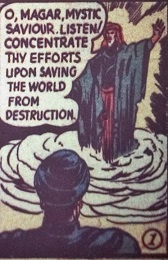
Comments: Solomon is a
legendary/historical figure first referenced in the first Book of Kings
in the Bible, which has been credited to various sources by various
sources, including the prophet Jeremiah and King Josiah.
Adapted to Timely/Marvel comics by an unidentified writer and artist.
The main image (from Marvel Tarot) was derived from Gustav Dore's illustrated Bible, and provided to me by David Sexton.
This
profile is primarily for the confirmed history of the Marvel Universe;
I have not the knowledge, time, or energy to debate the "facts" I've
included in the comments; consider the information as possible, or not,
for Reality-616 (aka, "the Prime Earth")...please don't argue real
world "facts" with me, as the Marvel Universe is obviously not the real
world...
I will be doing profiles on the Seal of Solomon, the Staff of Solomon,
and Solomon's Grotto. 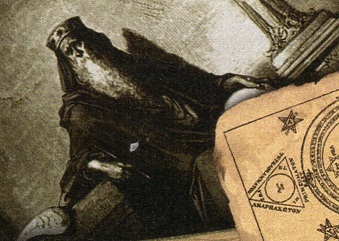
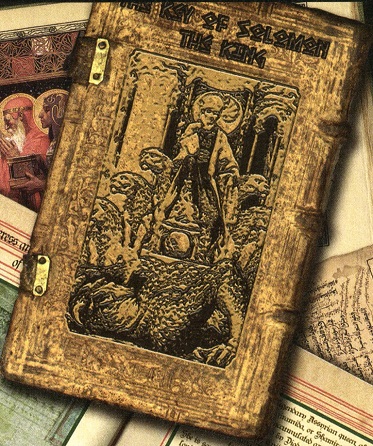 Solomon is a legendary and disputed historical figure in the real world. You can
search the internet for a wealth of information on him, but here's a
summary (we don't know how much of it is "true" in Reality-616),
courtesy of our old friend Wikipedia:
Solomon is a legendary and disputed historical figure in the real world. You can
search the internet for a wealth of information on him, but here's a
summary (we don't know how much of it is "true" in Reality-616),
courtesy of our old friend Wikipedia:
Solomon (/ˈsɒləmən/; Hebrew: שְׁלֹמֹה, Shlomoh), was also called Jedidiah (Hebrew יְדִידְיָהּ Yədidyah); Muslims generally refer to him by the Arabic variant Sulayman, son of David.
The life of Solomon is primarily described in the Hebrew Bible's second Book of Samuel, and by 1 Chronicles and 1 Kings.
Solomon was born in Jerusalem, the second born child of David (perhaps best known for the story of David and Goliath) and his wife Bathsheba, widow of Uriah the Hittite. The first child (unidentified in that account), a son conceived adulterously during Uriah's lifetime, had died as a punishment on account of the death of Uriah by David's order. Solomon had three named full brothers born to Bathsheba: Nathan, Shammua, and Shobab, besides six known older half-brothers born of as many mothers.
The
biblical narrative shows that Solomon served as a peace offering
between God and David, due to his adulterous relationship with
Bathsheba. In an effort to hide this sin, he sent the
woman's husband to battle, hoping that he would be killed there. After
he died, David was finally able to marry his wife. As punishment, the
first child, who was conceived during the adulterous relationship, died.
Solomon was born after David was forgiven.
While David was dying, Bathsheba and Nathan convinced David to proclaim Solomon king according to his earlier promise despite Solomon being younger than his brothers. It is said that Solomon ascended to the throne when he was only about fifteen.
In particular he
continued his father's very profitable relationship with the Phoenician
king Hiram I of Tyre (see 'wealth' below); they sent out joint expeditions to the lands of Tarshish and Ophir
to engage in the trade of luxury products, importing gold, silver,
sandalwood, pearls, ivory, apes and peacocks. Solomon is considered the
most wealthy of the Israelite kings named in the Bible.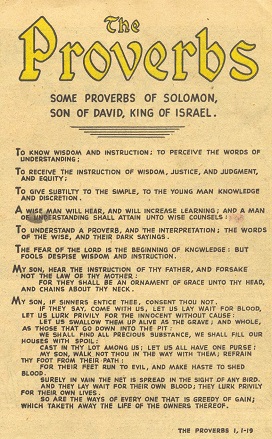
According to 1 Kings, Solomon sacrificed to God, and God later appeared to him in a dream asking what Solomon wanted from God. Solomon asked for wisdom. Pleased, God personally answered Solomon's prayer, promising him great wisdom because he did not ask for self-serving rewards like long life or the death of his enemies.
Solomon was traditionally considered the author of several biblical
books, "including not only the collections of Proverbs, but also of Ecclesiastes (from which the Byrds' song, "Turn, Turn, Turn" is based) and the Song of Solomon and the later apocryphal book the Wisdom of Solomon.
According to the biblical account, Solomon had 700 wives (including the daughter of an Egyptian Pharaoh) and 300 concubines.
The only wife mentioned by name is Naamah the Ammonite, mother of Solomon's successor, Rehoboam.
The Biblical narrative notes with disapproval that Solomon permitted
his foreign wives to import their national deities, building temples to
Ashtoreth (aka Ishtar) and Milcom (aka Moloch).
The Hebrew Bible describes how the fame of Solomon's wisdom and wealth spread far and wide, so much so that the queen of Sheba decided that she should meet him. The queen is described as visiting with a number of gifts including gold, spices and precious stones. When Solomon gave her "all her desire, whatsoever she asked," she left satisfied .
Because of Solomon's sins (primarily having many wives and worshiping
other gods) "the Lord punishes Solomon by removing 10 of the 12 Tribes
of Israel from the Israelites."
Solomon died of natural causes at around 60 years of age. Upon Solomon's death, his son, Rehoboam, succeeds him. However, ten of the Tribes of Israel refused to accept him as king, splitting the United Monarchy in the northern Kingdom of Israel under Jeroboam, while Rehoboam continued to reign over the much smaller southern Kingdom of Judah. Henceforth the two kingdoms are never again united.
King Solomon is one of the central Biblical figures in Jewish heritage that have lasting religious, national and political aspects. As the builder of the First Temple in Jerusalem and last ruler of the united Kingdom of Israel before its division into the northern Kingdom of Israel and the southern Kingdom of Judah,
Solomon is associated with the peak "golden age" of the independent
Kingdom of Israel as well as a source of judicial and religious wisdom.
Rabbinical tradition attributes the Wisdom of Solomon to Solomon, although this book was probably written in the 2nd century BC. In this work, Solomon is portrayed as an astronomer. Other books of wisdom poetry such as the Odes of Solomon and the Psalms of Solomon also bear his name. The Jewish historian Eupolemus, who wrote about 157 BC, included copies of apocryphal letters exchanged between Solomon and the kings of Egypt and Tyre.
The Gnostic Apocalypse of Adam, which may date to the 1st or 2nd century, refers to a legend in which Solomon sends out an army of demons to seek a virgin who had fled from him, perhaps the earliest surviving mention of the later common tale that Solomon controlled demons and made them his slaves. This tradition of Solomon's control over demons appears fully elaborated in the early pseudographical work called the Testament of Solomon with its elaborate and grotesque demonology.
Legends
A well-known story in the collection One Thousand and One Nights describes a genie who had displeased King Solomon and was punished by being locked in a bottle and thrown into the sea. Since the bottle was sealed with Solomon's seal, the genie was helpless to free himself, until freed many centuries later by a fisherman who discovered the bottle. In other stories from the One Thousand and One Nights, protagonists who had to leave their homeland and travel to the unknown places of the world saw signs which proved that Solomon had already been there. Sometimes, protagonists discovered words of Solomon that were intended to help those who were lost and had unluckily reached those forbidden and deserted places.
According to the Rabbinical literature, on account of his modest request for wisdom only, Solomon was rewarded with riches and an unprecedented glorious realm, which extended over the upper world inhabited by the angels and over the whole of the terrestrial globe with all its inhabitants, including all the beasts, fowl, and reptiles, as well as the demons and spirits. His control over the demons, spirits, and animals augmented his splendor, the demons bringing him precious stones, besides water from distant countries to irrigate his exotic plants. The beasts and fowl of their own accord entered the kitchen of Solomon's palace, so that they might be used as food for him, and extravagant meals for him were prepared daily by each of his 700 wives and 300 concubines, with the thought that perhaps the king would feast that day in her house.
Angels also helped Solomon in building the Temple; though not by choice. The edifice was, according to rabbinical legend, miraculously constructed throughout, the large heavy stones rising and settling in their respective places of themselves. The general opinion of the Rabbis is that Solomon hewed the stones by means of a shamir, a mythical worm whose mere touch cleft rocks. According to Midrash Tehillim, the shamir was brought from paradise by Solomon's eagle; but most of the rabbis state that Solomon was informed of the worm's haunts by Asmodeus. The shamir had been entrusted by the prince of the sea to the mountain rooster alone, and the rooster had sworn to guard it well, but Solomon's men found the bird's nest, and covered it with glass. When the bird returned, it used the shamir to break the glass, whereupon the men scared the bird, causing it to drop the worm, which the men could then bring to Solomon.
A magic ring called the "Seal of Solomon" was supposedly given to Solomon and gave him power over demons or Jinn. The magical symbol said to have been on the Seal of Solomon which made it efficacious is often considered to be the Star of David though this emblem (also known as the Shield of David) is known to have been associated with Judaism only as recently as the 11th century AD while the five pointed star (pentagram) can be found on jars and other artifacts from Jerusalem dating back to at least the 2nd and 4th centuries BC and is more likely to have been the emblem found on the ring purportedly used by King Solomon to control the Jinn or demons. Asmodeus, king of demons, was one day, according to the classical Rabbis, captured by Benaiah using the ring, and was forced to remain in Solomon's service. In one tale, Asmodeus brought a man with two heads from under the earth to show Solomon; the man, unable to return, married a woman from Jerusalem and had seven sons, six of whom resembled the mother, while one resembled the father in having two heads. After their father's death, the son with two heads claimed two shares of the inheritance, arguing that he was two men; Solomon decided that the son with two heads was only one man. The Seal of Solomon, in some legends known as the Ring of Aandaleeb, was a highly sought after symbol of power. In several legends, different groups or individuals attempted to steal it or attain it in some manner.
One legend concerning Asmodeus (see: The Story of King Solomon and Ashmedai) goes on to state that Solomon one day asked Asmodeus what could make demons powerful over man, and Asmodeus asked to be freed and given the ring so that he could demonstrate; Solomon agreed but Asmodeus threw the ring into the sea and it was swallowed by a fish. Asmodeus then swallowed the king, stood up fully with one wing touching heaven and the other earth, and spat out Solomon to a distance of 400 miles. The Rabbis claim this was a divine punishment for Solomon's having failed to follow three divine commands, and Solomon was forced to wander from city to city, until he eventually arrived in an Ammonite city where he was forced to work in the king's kitchens. Solomon gained a chance to prepare a meal for the Ammonite king, which the king found so impressive that the previous cook was sacked and Solomon put in his place; the king's daughter, Naamah, subsequently fell in love with Solomon, but the family (thinking Solomon a commoner) disapproved, so the king decided to kill them both by sending them into the desert. Solomon and the king's daughter wandered the desert until they reached a coastal city, where they bought a fish to eat, which just happened to be the one which had swallowed the magic ring. Solomon was then able to regain his throne and expel Asmodeus. The element of a ring thrown into the sea and found back in a fish's belly also appeared in Herodotus' account of Polycrates, the tyrant of Samos from c. 538 BC to 522 BC.
In another familiar version of the legend of the Seal of Solomon, Asmodeus disguises himself. In some myths, he's disguised as King Solomon himself, while in more frequently heard versions he's disguised as a falcon, calling himself Gavyn (Gavinn or Gavin), one of King Solomon's trusted friends. The concealed Asmodeus tells travelers who have ventured up to King Solomon's grand lofty palace that the Seal of Solomon was thrown into the sea. He then convinces them to plunge in and attempt to retrieve it, for if they do they would take the throne as king.
Other magical items attributed to Solomon are his key and his Table. The latter was said to be held in Toledo, Spain during Visigoth rule and was part of the loot taken by Tarik ibn Ziyad during the Umayyad Conquest of Iberia, according to Ibn Abd-el-Hakem's History of the Conquest of Spain. The former appears in the title of the Lesser Key of Solomon, a grimoire whose framing story is Solomon capturing demons using his ring, and forcing them to explain themselves to him. In The Book of Deadly Names,
purportedly translated from Arabic manuscripts found hidden in a
building in Spain, the "King of the Jinn" Fiqitush brings 72 Jinn
before King Solomon to confess their corruptions and places of
residence. Fiqitush tells King Solomon the recipes for curing such
corruptions as each evil Jinn confesses.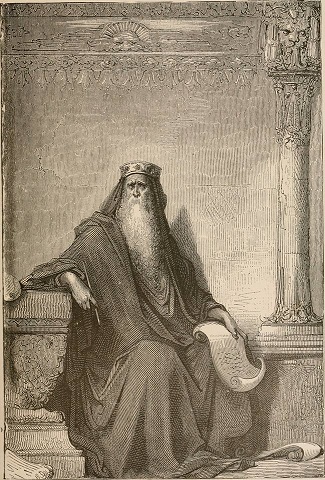
Early adherents of the Kabbalah portray Solomon as having sailed through the air on a throne of light placed on an eagle, which brought him near the heavenly gates as well as to the dark mountains behind which the fallen angels Uzza and Azzazel were chained; the eagle would rest on the chains, and Solomon, using the magic ring, would compel the two angels to reveal every mystery he desired to know.
According to one legend, while traveling magically, Solomon noticed a magnificent palace to which there appeared to be no entrance. He ordered the demons to climb to the roof and see if they could discover any living being within the building but they found only an eagle, which said that it was 700 years old, but that it had never seen an entrance. An elder brother of the eagle, 900 years old, was then found, but it also did not know the entrance. The eldest brother of these two birds, which was 1,300 years old, then declared it had been informed by its father that the door was on the west side, but that it had become hidden by sand drifted by the wind. Having discovered the entrance, Solomon found an idol inside that had in its mouth a silver tablet saying in Greek (a language not thought by modern scholars to have existed 1000 years before the time of Solomon) that the statue was of Shaddad, the son of 'Ad, and that it had reigned over a million cities, rode on a million horses, had under it a million vassals and slew a million warriors, yet it could not resist the angel of death.
Shalim (Shalem, Salem, and Salim) is a god in the Canaanite religion pantheon, mentioned in inscriptions found in Ugarit (Ras Shamra) in Syria. In the Dictionary of Deities and Demons in the Bible, Shalim is also identified as the deity representing Venus or the "Evening Star", and Shahar, the "Morning Star". His name derives from the triconsonantal Semitic root S-L-M. The city of Jerusalem was named after him, and the biblical King Solomon may also have been.
In a distant cosmos, Solomon granted his wisdom to the heroic Captain Marvel as the first "S" in "SHAZAM!"
Solomon's lineage per the Bible according to Dim I Nticoudis:
The genealogies included in the Bible depict Solomon as a direct descendant of Adam. The genealogy goes as following:
*Generation 1: Solomon. Son of David and Bathsheba. See: https://en.wikipedia.org/wiki/David and https://en.wikipedia.org/wiki/Bathsheba
*Generation 2: David. Son of Jesse. See: https://en.wikipedia.org/wiki/Jesse
*Generation 3: Jesse. Son of Obed. See: https://en.wikipedia.org/wiki/Obed_(biblical_figure)
*Generation 4: Obed. Son of Boaz and Ruth. His mother was from Moab. See: https://en.wikipedia.org/wiki/Boaz and https://en.wikipedia.org/wiki/Ruth_(biblical_figure)
*Generation 5: Boaz. Son of Salmon and Rahab. His mother was possibly Rahab of Jericho, the prostitute who helped the Israelites capture the city. See: https://en.wikipedia.org/wiki/Salmon_(biblical_figure) and https://en.wikipedia.org/wiki/Rahab
*Generation 6: Salmon. Son of Nahshon, tribal leader of the Tribe of Judah. Nahshon was reportedly one of the military commanders serving under Moses, and was also the brother-in-law of Aaron. See: https://en.wikipedia.org/wiki/Nahshon
*Generation 7: Nahshon. Son of Amminadab. Amminadab was born in Egypt, and was reportedly the father-in-law of Aaron and ancestor to the Aaronite priests. See: https://en.wikipedia.org/wiki/Amminadab
*Generation 8: Amminadab.
Son of Ram/Aram. See: https://en.wikipedia.org/wiki/Ram_(biblical_figure)
*Generation 9: Ram/Aram. Son of Hezron. See: https://en.wikipedia.org/wiki/Hezron
*Generation 10) Hezron. Son of Perez. Perez was the twin brother of Zerah. See: https://en.wikipedia.org/wiki/Perez_(son_of_Judah)
*Generation 11) Perez. Son of Judah and Tamar. Judah was the eponymous ancestor of the Tribe of Judah. Tamar was Judah's daughter-in-law. After his sons failed to impregnate Tamar, Judah had sex with her and accomplished the deed wth a one-night-stand. See: https://en.wikipedia.org/wiki/Judah_(son_of_Jacob) and https://en.wikipedia.org/wiki/Tamar_(Genesis)
*Generation 12: Judah. Son of Jacob/Israel and Leah. Jacob was the eponymous ancestor of the Israelites. Leah was one of the daughters of Laban, and an older sister of Rachel. Both Leah and Rachel married their paternal first cousin Jacob. See: https://en.wikipedia.org/wiki/Jacob and https://en.wikipedia.org/wiki/Leah
*Generation 13: Jacob. Son of Isaac and Rebecca. Isaac was son and heir to Abraham. Rebecca was sister to Laban, and paternal aunt to Leah and Rachel. Rebecca was a grand-niece of Abraham, who chose her as bride to Isaac for this reason. He did not want his soon to marry outside his family. See: https://en.wikipedia.org/wiki/Isaac and https://en.wikipedia.org/wiki/Rebecca
*Generation 14) Isaac. Son of Abraham and Sarah. Sarah was Abraham's wife, and also either his sister or paternal half-sister. The siblings were reportedly from the city of Ur. See: https://en.wikipedia.org/wiki/Abraham and https://en.wikipedia.org/wiki/Sarah and https://en.wikipedia.org/wiki/Ur_of_the_Chaldees
*Generation 15) Abraham. Son of Terah, a polytheist from Ur. See: https://en.wikipedia.org/wiki/Terah
*Generation 16) Terah. Son of Nahor. Nahor was reportedly from the city-state of Ur. See: https://en.wikipedia.org/wiki/Nahor,_son_of_Serug and https://en.wikipedia.org/wiki/Ur
*Generation 17: Nahor. Son of Serug, a resident of Ur. Serug was supposedly a sorcerer and teacher of sorcery. See: https://en.wikipedia.org/wiki/Serug
*Generation 18: Serug. Son of Reu. Reu was supposedly born at the time of the construction of the Tower of Babel. See: https://en.wikipedia.org/wiki/Reu and https://en.wikipedia.org/wiki/Tower_of_Babel
*Generation 19) Reu. Son of Peleg. Peleg was alive at the time the descendants of Noah divided the Earth among themselves. See: https://en.wikipedia.org/wiki/Peleg
*Generation 20) Peleg. Son of Eber, eponymous ancestor of the Hebrews. Eber is depicted as an ancestor to the israelites and the Ishmaelites. See: https://en.wikipedia.org/wiki/Eber
*Generation 21: Eber. Son of Salah. See: https://en.wikipedia.org/wiki/Salah_(biblical_figure)
*Generation 22: Salah. Son of Cainan. Cainan appears in the Septuagint, but not the Masoretic text (which skips a generation). Cainan was supposedly the founding father of astrology, and possibly astronomy. See: https://en.wikipedia.org/wiki/Cainan
*Generation 23: Cainan. Son of Arphachsad. Arphachsad
was supposedly one of the sons of Shem, and a brother to Elam, Asshur, Lud, and Aram. See: https://en.wikipedia.org/wiki/Arpachshad
*Generation 24) Arphachsad. Son of Shem. Shem was the eponymous ancestor of the Semitic people. The
Semitic languages (named after him) are a subset of the Afro-Asiatic languages, denoting the common linguistic heritage of Arabic, Aramaic, Akkadian, Ethiopic, Hebrew, and Canaanite-Phoenician languages. See: https://en.wikipedia.org/wiki/Shem
*Generation 25: Shem. Son of Noah. Noah is the protagonist of the Genesis flood narrative, where he survives a great flood. See: https://en.wikipedia.org/wiki/Noah and https://en.wikipedia.org/wiki/Genesis_flood_narrative
*Generation 26: Noah. Son of Lamech. See: https://en.wikipedia.org/wiki/Lamech_(father_of_Noah)
*Generation 27: Lamech. Son of Methuselah. Methuselah was 969-years-old at the time of his death, the longest-lived human character in the Bible. See: https://en.wikipedia.org/wiki/Methuselah
*Generation 28: Methuselah. Son of Enoch. Enoch reportedly did not die, but entered heaven while still alive. According to post-biblical traditions he was transformed from human to an archangel. He is at times identified with Metatron, the celestial scribe. See: https://en.wikipedia.org/wiki/Enoch_(ancestor_of_Noah) and https://en.wikipedia.org/wiki/Metatron
*Generation 29: Enoch. Son of Jared. Mentioned as one of the descendants of Seth, but he is possibly identical to Irad (a descendant of Cain). See: https://en.wikipedia.org/wiki/Jared_(biblical_figure) and https://en.wikipedia.org/wiki/Irad
*Generation 30: Jared. Son of Mahalalel. See: https://en.wikipedia.org/wiki/Mahalalel
*Generation 31: Mahalalel. Son of Kenan. See: https://en.wikipedia.org/wiki/Kenan
*Generation 32: Kenan. Son of Enos. See: https://en.wikipedia.org/wiki/Enos_(biblical_figure)
*Generation 33: Enos. Son of Seth. Seth was reportedly the third son of Adam and Eve, and a younger brother to Cain and Abel. See: https://en.wikipedia.org/wiki/Seth
*Generation 34: Seth. Son of Adam and Eve. See: https://en.wikipedia.org/wiki/Adam and https://en.wikipedia.org/wiki/Eve
Profile by Snood.
CLARIFICATIONS:
Solomon should be distinguished from:
images: (without ads)
Black Panther Annual#1 (2008), last page, panel 3 (full) & 4 (face, profile)
Marvel Preview#19/2, pg. 11, panel 6 (banishing demon)
Marvel Tarot#1, pg. 9, upper right quadrant panels
Red Raven#1, pg. 1, panel 4 (spirit appearing before Magar);
Bible Tales#1, pg 13: Proverbs
Bible Tales#4, pg. 20 (introductory panel; judgment of Solomon);
panel 4 (Solomon kneeling beside the dying David);
pg. 21 (or Solomon's story pg. 2), panel 3 (Solomon sacrificing to God)
Appearances:
Red Raven#1 (August, 1940) - Unrevealed writer and artist
Bible Tales#1 (August, 1953) - Unrevealed writer; Don Rico (penciler, inker),
Bible Tales#4 (February, 1954) - Unrevealed writer and artist
Black Panther I#1 (January, 1977) - Jack Kirby (writer, penciler, editor), Michael W. Royer (inker)
Black Panther I#2 (March, 1977) - Jack Kirby (writer, penciler, editor), Michael W. Royer (inker)
Black Panther I#3 (May, 1977) - Jack Kirby (writer, penciler, editor), Michael W. Royer (inker)
Black Panther I#4 (July, 1977) - Jack Kirby (writer, penciler, editor), Michael W. Royer (inker)
Marvel Preview#19: Solomon Kane story (October,
1979) - Don Glut (writer), Will Meugniot (penciler), Steve Gan (inker),
Mark Gruenwald (associate editor), Roy Thomas (editor)
(Sword of) Solomon Kane#1 (September, 1985) - Ralph Macchio (writer),
Bret Blevins & Steve Car (pencilers), Bret Blevins (inker)
(Sword of) Solomon Kane#2 (November, 1985) - Ralph
Macchio (writer), Bret Blevins (penciler), Bret
Blevins (inker)
(Sword of) Solomon Kane#3 (January, 1986) - Ralph
Macchio (writer), Bret Blevins (penciler), Al Williamson (inker)
(Sword of) Solomon Kane#4 (March, 1986) - Ralph
Macchio (writer), Michael Mignola (penciler), Al Williamson (inker)
(Sword of) Solomon Kane#5 (May, 1986) - Ralph
Macchio (writer), Jon Bogdanove (penciler), Al Williamson (inker)
(Sword of) Solomon Kane#6 (July, 1986) - Ralph
Macchio (writer), John Ridgway (penciler), Al Williamson (inker)
Alpha Flight II#16 (November, 1998) - Duncan Rouleau &
Steven T. Seagle (writer), Duncan Rouleau (penciler), Cabin Boy, Robert
Hunter, Aaron Sowd (inkers), Lysa Kraiger (assistant editor), Jaye
Gardner (editor)
Fantastic Four Annual '99 (1999) - Chris Claremont (writer), Jose Ladronn (artist), Bobbie Chase (editor)
Marvel
Tarot (2007) - David Sexton (writer/designer), Doug Sexton (technical
consultant), Jeff Christiansen (continuity consultant), Michael Short
& Cory Levine (assistant editors), Mark D. Beazley & Jennifer
Grunwald (associate editors), Jeff Youngquist (editor)
Black Panther Annual#1 (2008) - Reginald Hudlin
(writer), Larry Stroman & Ken Lashley (pencilers), Roland Paris,
Carlos Cuevas, & Jon Sibal (inkers), Daniel Ketchum (assistant
editor), Axel Alonso (editor)
Official Handbook of the Marvel Universe A to Z
(hardcover) Vol. 6: Lilith (Mother of Demons) (February, 2009) - Ronald
Byrd & Jeff Christiansen (writers), Jeff Christiansen (head
writer), Madison Carter,
Mike Fichera & Stuart Vandal (coordination assistants), Jeff
Youngquist & Jennifer Grunwald (editors)
Official Handbook of the Marvel Universe A to Z
(hardcover) Vol. 7: Appendix: Magic (from the journals of Ian
McNee) (May, 2009) - David Sexton (writer), Jeff Christiansen (head writer), Madison Carter,
Mike Fichera & Stuart Vandal (coordination assistants), Jeff
Youngquist & Jennifer Grunwald (editors)
Ghost Riders:
Heaven's on Fire#2 (November, 2009) - Jason Aaron (writer), Roland Boschi (penciler & inker), Sebastian Girner (editor)
Captain America: Hail Hydra#3 (May, 2011) - Jonathan Mayberry (writer),
Phil Winslade (penciler & inker), Rachel Pinnelas (assistant
editor), Thomas Brennan (editor)
First posted: 09/26/2018
Last updated: 05/07/2023
Any Additions/Corrections? please let me know.
Non-Marvel Copyright info
All other characters mentioned or pictured are ™ and
© 1941-2099 Marvel Characters, Inc. All Rights Reserved. If you
like this stuff, you should check out the real thing!
Please visit The Marvel Official Site at: http://www.marvel.com
Special Thanks to www.g-mart.com for hosting the Appendix, Master List, etc.!